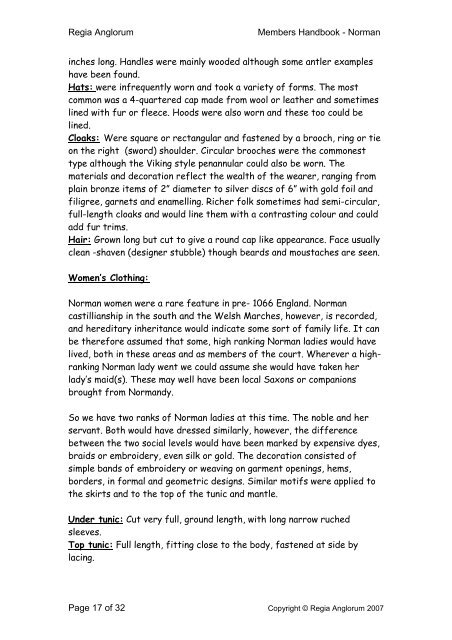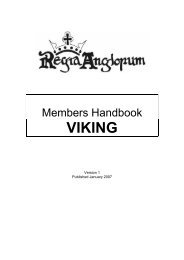Members Handbook - Norman - Regia Anglorum
Members Handbook - Norman - Regia Anglorum
Members Handbook - Norman - Regia Anglorum
You also want an ePaper? Increase the reach of your titles
YUMPU automatically turns print PDFs into web optimized ePapers that Google loves.
<strong>Regia</strong> <strong>Anglorum</strong> <strong>Members</strong> <strong>Handbook</strong> - <strong>Norman</strong><br />
inches long. Handles were mainly wooded although some antler examples<br />
have been found.<br />
Hats: were infrequently worn and took a variety of forms. The most<br />
common was a 4-quartered cap made from wool or leather and sometimes<br />
lined with fur or fleece. Hoods were also worn and these too could be<br />
lined.<br />
Cloaks: Were square or rectangular and fastened by a brooch, ring or tie<br />
on the right (sword) shoulder. Circular brooches were the commonest<br />
type although the Viking style penannular could also be worn. The<br />
materials and decoration reflect the wealth of the wearer, ranging from<br />
plain bronze items of 2” diameter to silver discs of 6” with gold foil and<br />
filigree, garnets and enamelling. Richer folk sometimes had semi-circular,<br />
full-length cloaks and would line them with a contrasting colour and could<br />
add fur trims.<br />
Hair: Grown long but cut to give a round cap like appearance. Face usually<br />
clean -shaven (designer stubble) though beards and moustaches are seen.<br />
Women’s Clothing:<br />
<strong>Norman</strong> women were a rare feature in pre- 1066 England. <strong>Norman</strong><br />
castillianship in the south and the Welsh Marches, however, is recorded,<br />
and hereditary inheritance would indicate some sort of family life. It can<br />
be therefore assumed that some, high ranking <strong>Norman</strong> ladies would have<br />
lived, both in these areas and as members of the court. Wherever a highranking<br />
<strong>Norman</strong> lady went we could assume she would have taken her<br />
lady’s maid(s). These may well have been local Saxons or companions<br />
brought from <strong>Norman</strong>dy.<br />
So we have two ranks of <strong>Norman</strong> ladies at this time. The noble and her<br />
servant. Both would have dressed similarly, however, the difference<br />
between the two social levels would have been marked by expensive dyes,<br />
braids or embroidery, even silk or gold. The decoration consisted of<br />
simple bands of embroidery or weaving on garment openings, hems,<br />
borders, in formal and geometric designs. Similar motifs were applied to<br />
the skirts and to the top of the tunic and mantle.<br />
Under tunic: Cut very full, ground length, with long narrow ruched<br />
sleeves.<br />
Top tunic: Full length, fitting close to the body, fastened at side by<br />
lacing.<br />
Page 17 of 32 Copyright © <strong>Regia</strong> <strong>Anglorum</strong> 2007



